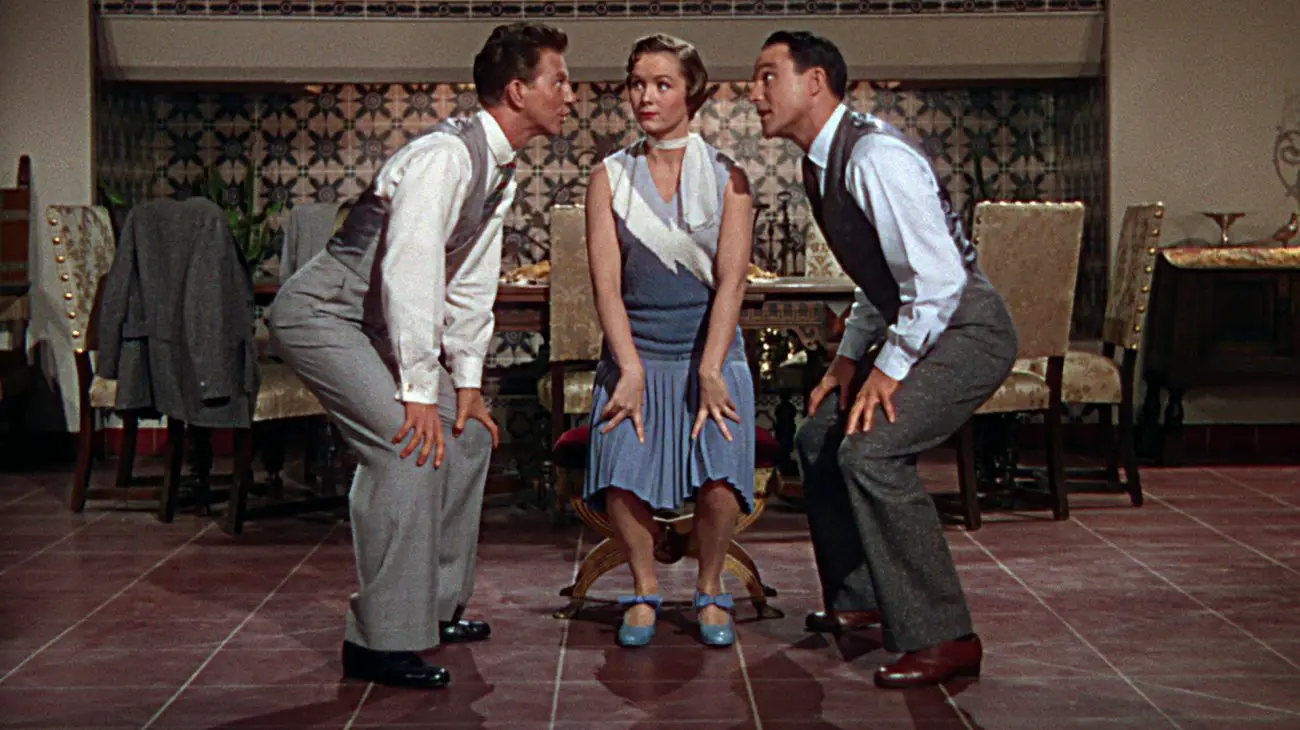
Taking place at the start of the talking picture era, Singin’ in the Rain will go down in cinema history as the best movie musical of all-time.
The late 1920s were an interesting time for the motion picture business. Silent pictures were all the rave but things changed when Warner Brothers premiered The Jazz Singer. Producing a movie musical about this era in time is a genius move on Arthur Freed’s part. While many executives believed talking pictures to be the thing of the future, others were weary of adding sound. In some ways, the film is a satire of this era but believe it or not, the sound era did end careers. Lina Lamont (Jean Hagen) is the perfect example of this. Once she opens her mouth, her career is practically doomed.
The film plays up Gene Kelly’s strengths as a song-and-dance guy in his performance of Don Lockwood. Lockwood’s partner during his vaudeville days is Cosmo Brown (Donald O’Connor). The two are partners for life. They both move to California and work at Monumental Pictures. Lockwood quickly becomes one of the leading stuntmen and then a leading man in the silent era. Brown heads up the music department when Monumental transitions to sound.
The film’s three-part opening includes the first meeting between Lockwood and Kathy Selden (Debbie Reynolds). Naturally, Lockwood is shocked to see Kathy at a party and before you know it, he’s head over heels for her. That is, if he could ever find her again! To his credit, Cosmo sings “Make ‘Em Laugh” to cheer him up but it only does so much. When Cosmo later spots Kathy in another production, he rushes to get Don and the studio signs Kathy to a contract. This was at a time when studios signed actors to multi-year contracts. Oh, how things have changed!
It’s a no-brainer that studio head R.F. Simpson (Millard Mitchell) converts The Dueling Cavalier into a talking picture. What he–and most everyone else–doesn’t realize is that Lina’s New York accent isn’t made for the sound era. The production goes terrible but the lightbulb goes off when Don, Kathy, and Cosmo turn the film into a musical. Good news for Kathy but terrible news for Lina. The move pays off during the film’s premiere.
Don isn’t a fan of Monumental pairing him with leading lady Lina Lamont. It’s one of those pairings that are just for show. Lina, however, won’t have any of it even when Don reveals his feelings for Kathy. This is what especially makes the film’s ending such a joy to watch.
What’s so fascinating about Gene Kelly’s iconic performance is that he was practically ignored during awards season. Maybe this is because he was known to be a tyrant on set but I don’t know. To watch Kelly perform “Singin’ in the Rain” is like watching the perfect sunset. It’s so beautiful. You never want it to end but of course, it must. The choreography here is top-notch. Even in doing this film so soon after An American in Paris, Kelly never loses a beat.
Meanwhile, Jean Hagen picked up an Oscar nomination for her performance. Lennie Hayton was also nominated for Best Original Score. Aside from that, the Golden Globes honored Donald O’Connor with Best Supporting Actor (Musical/Comedy). But enough about awards…
Screenwriters Betty Comden and Adolph Green add two songs of their own: “Make ‘Em Laugh” and “Moses Supposes.” Otherwise, the film takes advantage of Arthur Freed and Nacio Herb Brown’s 1929-1939 catalog at MGM. The headlining song being “Singin’ in the Rain,” of course. Not all musicals are able to eloquently tie in a story between the music but this film certainly does.
When it comes to musicals, Singin’ in the Rain has it all.
DIRECTORS: Gene Kelly and Staney Donen
SCREENWRITERS: Betty Comden and Adolph Green
CAST: Gene Kelly, Donald O’Connor, Debbie Reynolds, with Jean Hagen, Millard Mitchell and Cyd Charisse





